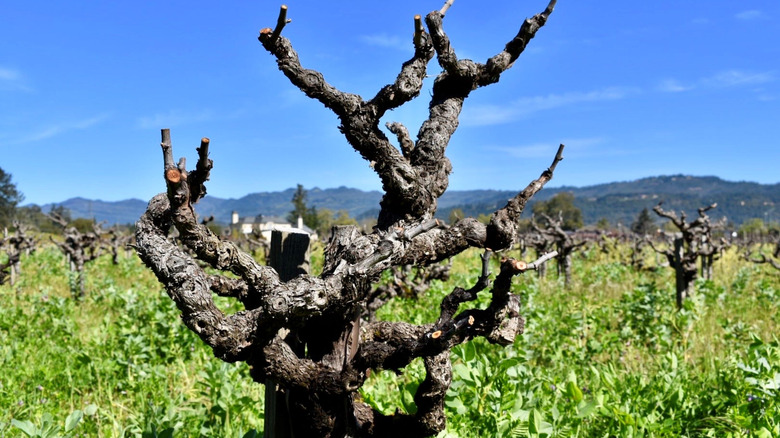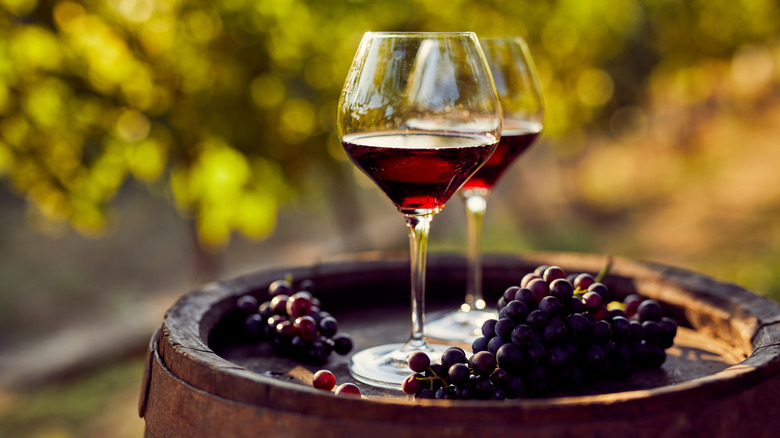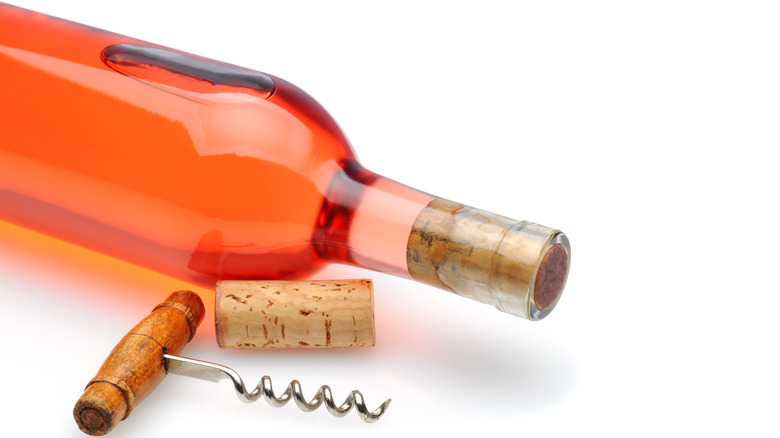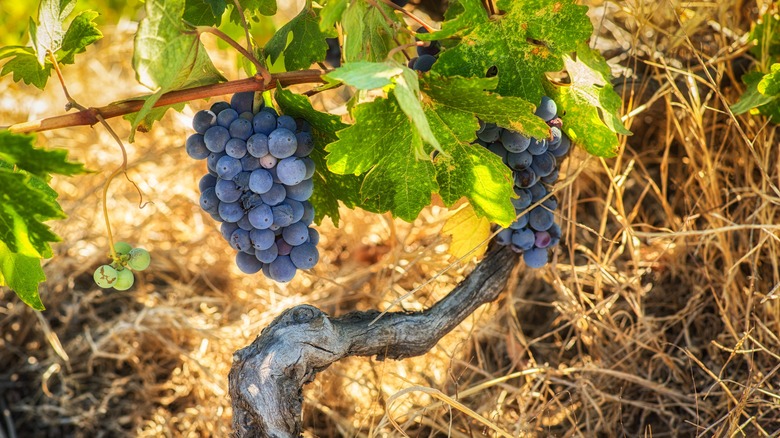The Accident That Saved Old Vine Zinfandel In California
To folks who aren't wine drinkers, old vine Zinfandel might not seem appealing. The vines themselves are gnarled, twisted things, and the yield of the oldest grapevines hardly makes economic sense. Grapevines are pretty darn long-lived; the oldest vine that still produces fruit is about 400 years old and located in Slovenia, but that's the exception, rather than the rule. According to a 2021 study published in Plants, most vineyards age out at 30-50 years old, then they're replanted.
Zinfandel is a bit of an exception, though. Culinary Wine & Food Adventures explains that the oldest vineyard (with a paper trail, at least) in California is the Original Grandpere Vineyard, also known as Vineyard 1869, named for the year it was planted. If our math's right, that makes the Zinfandel vines 154 years old.
The vines don't produce much fruit — about one ton of grapes per acre each year — but what fruit they do produce is heavenly. Sacramento Magazine describes fruit from the oldest Zinfandel vines as "distinct and spicy, with aroma and taste characteristics that teeter between ripe raspberry and blackberry brightened by a juicy backbone."
While VinePair correctly points out that "old vine" isn't a legally regulated term, meaning wineries can (and sometimes do) label any wine as being old vine, typically the term is used to apply to vineyards over 50 years of age. And were it not for a happy accident, we might not have old vine Zinfandel to drink today.
Zinfandel hasn't always been en vogue
Zinfandel vines migrated to California from the East Coast along with fortune hunters during the 1849 Gold Rush, and the grape variety was popular both because it was easy to cultivate and because it made a rich, satisfying wine enjoyed by thirsty miners, per Plume Ridge Bottle Shop. During Prohibition, while many wineries closed their doors, growers of Zinfandel simply shipped grapes to home winemakers, keeping the grape business afloat.
But after Prohibition, Zinfandel's popularity was eclipsed by other grape varieties as California winemakers chased, competed with, and finally achieved the unthinkable when they surpassed French wines in quality in the famous Judgment of Paris tasting in 1976, in which California Cabernet Sauvignon and Chardonnay won top honors (via Wine Enthusiast).
Bob Trinchero, whose family owns the Napa Valley-based Sutter Home Winery, explained Zin's predicament in an interview with the Milwaukee Journal Sentinel, saying, "In the early and mid-1970s, Zinfandel was going out of favor," said Trinchero. "People were ripping out Zinfandel vines and planting Chardonnay, Cabernet, and Pinot Noir. But all of a sudden that stopped." What saved those old Zinfandel vines? It was an accident, and Bob Trinchero is delighted to take the blame.
An accident at Sutter Home brought Zinfandel back
Bob Trinchero told the Milwaukee Journal Sentinel that he began using the saignée method of bleeding off some of the first-press juice to intensify the flavor of his 1972 red Zinfandel, which left him with about 220 gallons of pale-colored juice, which he fermented and bottled as a dry rosé, selling half of it to a friend who owned a grocery store in Sacramento. Trinchero made about 200 cases of the "White Zinfandel" again in 1974.
1975 was the year everything changed. Trinchero had about 800 gallons of juice fermenting in a tank, destined to become a dry rosé, and there was a problem. He explained, "It stopped fermenting for whatever reason. It didn't ferment all the sugar out. I took a sample and tasted it and it was a little sweet and slightly pink — maybe I'd pressed the skins a little too much. But, it's not too bad, I thought."
Unable to get the wine to ferment out completely dry, thrifty Bob Trinchero just bottled it. The wine had about 2% residual sugar, which made it noticeably sweet, and the new style of Sutter Home White Zinfandel became a huge success, appealing particularly to new wine drinkers who didn't necessarily want to study wine, but rather simply enjoy it.
White Zinfandel saved old vine Zinfandel
Roger Trinchero, Bob's brother, said the White Zinfandel "was like having the reins of a runaway horse," according to SevenFifty Daily. Roger and Bob both labored to keep up with the demand for the new wine. According to Roger, both brothers worked long days to load cases of White Zin onto trucks lined up on Highway 29 in front of the Sutter Home winery.
Other wineries were slow to join what would become the White Zin craze. Roger said he and his brother were accused of "bastardizing" Zinfandel with the sweet wine, which created the space for Sutter Home to corner the market on the sweet blush wine, eventually becoming the best-selling wine in the U.S. with annual sales of 3 million cases annually, according to the Milwaukee Journal Sentinel. And Sutter Home is proud of the role it played in recognizing the consumer appeal of White Zinfandel, which led to the preservation of old vine Zinfandel vineyards that otherwise would have been ripped up and replanted to other grape varieties.
We now know, thanks to the work done by plant geneticist Carole Meredith and others, that our all-American Zinfandel originated in Croatia as a grape called Crljenak Kaštelanski, also known in the Middle Ages as Tribidrag (via Grape Collective). That said, Zinfandel, according to Vindulge, is currently the third most widely planted grape in California, thanks in large part to Bob Trinchero's stuck fermentation.



